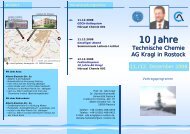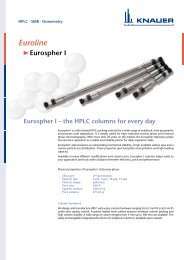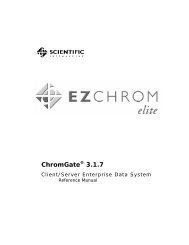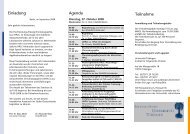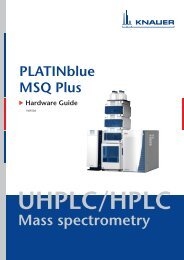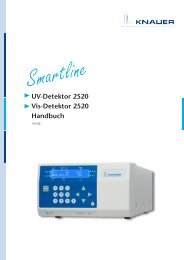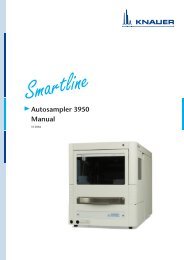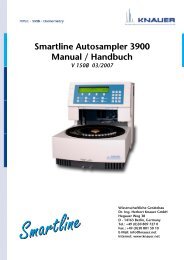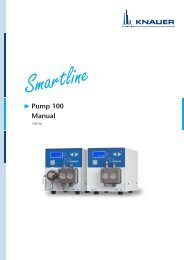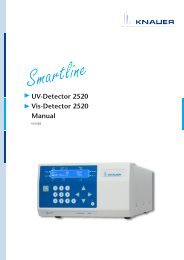ChromeGate 3.3.2 Software Manual - KNAUER Advanced Scientific ...
ChromeGate 3.3.2 Software Manual - KNAUER Advanced Scientific ...
ChromeGate 3.3.2 Software Manual - KNAUER Advanced Scientific ...
Create successful ePaper yourself
Turn your PDF publications into a flip-book with our unique Google optimized e-Paper software.
Creating an Instrument Control Method 159<br />
WL shows two different values: the current wave length and the signal.<br />
The wave length’s unit is nm; the signal unit depends on the unit that has<br />
been chosen in the ASM2.1L configuration for the detector.<br />
The right-handed part of the UV section allows for direct control of the<br />
detector, independently from the method setup. During a run this part is<br />
not accessible beside the autozero (AZ) button.<br />
WL: (Direct Control)<br />
Enter the desired wave length for the detector click on the button<br />
to change the wave length in the detector. If the wave length is out of the<br />
acceptable wave length range, an appropriate error message will be<br />
shown.<br />
Fig. 235 Error message Wavelength out of range<br />
Lamp OFF / Lamp On button (Direct Control)<br />
This button allows for switching off or on the detector lamp. The button’s<br />
labeling indicates, what will happen if the button is pressed; it does not<br />
show the lamp status! If the lamp is on, the button shows “Lamp OFF”,<br />
because the lamp will be switched off, if you click on it. It shows “Lamp<br />
ON” if the detector lamp is off – clicking the button will switch on the<br />
lamp. While the deuterium lamp is heating, the (inaccessible) button<br />
shows “Heating”.<br />
AZ button (Direct Control)<br />
If you click on this button, the detector will perform an autozero, which<br />
means, the current signal will be set to 0 (zero). This button will also be<br />
active during a run, please be careful then: Clicking this button if a peak<br />
elutes will make the peak information (area, maybe also retention time)<br />
unusable.<br />
Valve(s)<br />
The left-handed part of the Valve(s) section shows the valves current<br />
position.<br />
Fig. 236 ASM2.1L status tab – Valve(s)<br />
Position: (Status)<br />
The current position of all configured valves will be shown. For each<br />
valve the name given in the configuration is shown. If the AMS2.1L is<br />
configured using the “Auto Configuration” option, the default name for a<br />
valve is “Valve”, followed by an extension for the valve’s position in the<br />
ASM2.1L case (L = left, M = middle, R = right). For Knauer two-position<br />
valves the position can be either I (injection) or L (load), for Valco twoposition<br />
valves A or B. For multi-position valves the position can be 1 –<br />
16, depending on the valves configuration.<br />
The right-handed part of the Valve(s) section allows for direct control of<br />
the valve(s), independently from the method setup. During a run this part<br />
is not accessible.




